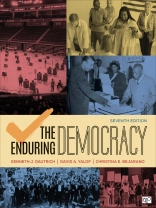How can our history provide us with a roadmap to the future?
The Enduring Democracy offers the essentials of American government with a focus on placing current issues and controversies into a historical perspective. By looking back, students can use the context of our country to understand that the troubles we face are often newer versions of past dilemmas. This allows them to tap into those ‘lessons learned’ to identify, understand, and even provide solutions to today′s challenges. One modernizing force to all this comparison is the rapidly changing demographics in our population that asks us to reconsider many aspects of American political behavior and how that will influence both the present and future.
The Seventh Edition frames the 2022 midterm elections from the perspective of what they mean to students, so that they can see the relevance of American government in their daily lives.
This title is accompanied by a complete teaching and learning package.
- Learning Platform / Courseware
SAGE Vantage is an intuitive learning platform that integrates quality SAGE textbook content with assignable multimedia activities and auto-graded assessments to drive student engagement and ensure accountability. Unparalleled in its ease of use and built for dynamic teaching and learning, Vantage offers customizable LMS integration and best-in-class support. It’s a learning platform you, and your students, will actually love.
- Assignable Video with Assessment
Assignable video (available in SAGE Vantage) is tied to learning objectives and curated exclusively for this text to bring concepts to life.
- Assignable Video with Assessment
- LMS Cartridge: Import this title’s instructor resources into your school’s learning management system (LMS) and save time. Don’t use an LMS? You can still access all of the same online resources for this title via the password-protected Instructor Resource Site.
Tabela de Conteúdo
PART I FOUNDATIONS
Chapter 1 Introduction to The Enduring Democracy
Midterm Elections, History, Diversity, and American Politics
Forms and Functions of Government
American Government and Politics
American Political Culture
Is American Democracy in Decline?
Chapter 2 The Founding and the Constitution
The Beginnings of a New Nation
The Constitutional Convention
The New Constitution
The Ratification Battle
Changing the Constitution
Chapter 3 Federalism
What Is Federalism?
The History of American Federalism
Why Federalism? Advantages and Disadvantages
Chapter 4 Civil Liberties
The Bill of Rights: Origins and Evolution
Freedom of Religion and the Establishment Clause
Free Expression Rights
The Right to Bear Arms and the Rights of the Criminally Accused
The Modern Right to Privacy
Chapter 5 Civil Rights, Equality, and Social Movements
Types of Equality
The Struggle for Equality: Approaches and Tactics
The Struggle for Equality and Civil Rights
The Struggle for Equality: Gender, Sex, and Sexuality
Continuing Struggles Over Equality in the Modern Era
PART II INSTITUTIONS
Chapter 6 Congress
Article I and the Creation of Congress
The Structure and Organization of Congress
The Committee System
How a Bill Becomes a Law
Oversight and Personnel Functions of Congress
Constituent Service: Helping People Back Home
Chapter 7 The Presidency
Where Do Presidents Come From? Presidential Comings and Goings
The Evolution of the American Presidency
Express Powers and Responsibilities of the President
Implied Powers and Responsibilities of the President
Presidential Resources
Important Presidential Relationships
Chapter 8 The Federal Bureaucracy
What Is Bureaucracy?
What Does the Federal Bureaucracy Do?
The Development of the Federal Bureaucracy
Getting Control of the Growing Bureaucracy
The Organization of the Federal Bureaucracy
The Federal Workforce
Chapter 9 The Judiciary
Types of Law
The Structure of the U.S. Legal System
The Adversarial System of Justice
Judicial Review and Its Implications
Limitations on Courts
Electing and Appointing Judges
How a Case Proceeds Within the U.S. Supreme Court
Judicial Decision-Making and Debates Over the Exercise of Judicial Power
PART III POLITICAL BEHAVIOR
Chapter 10 Public Opinion
Public Opinion in American Politics
The Levels of Public Opinion
How Informed Is Public Opinion?
How Does Public Opinion Form?
How Is Public Opinion Measured?
Interpreting Public Opinion Data
Chapter 11 Interest Groups
Pluralism and the Interest-Group System
Interest Groups in Action
Types of Interest Groups
How Interest Groups Achieve Their Goals
Chapter 12 The Media and American Politics
The Media in American Politics
Historical Development of the Media
The Mass Media Today
Effects of the Media
Criticisms of the News Media
Chapter 13 Political Parties and Voting
The Development of Political Parties in the United States
The Functions of Political Parties
Why a Two-Party System?
Party Organizations
Voting
Exercising the Franchise
Participation Beyond Voting
Chapter 14 Campaigns and Elections
American Presidential Elections in Historical Perspective
The Nomination Campaign
The General Election Campaign
The Advertising
Campaign Funding
Congressional Campaigns and Elections
PART IV PUBLIC POLICY
Chapter 15 American Public Policy
An Overview of the Policy-Making Process
Theories and Practice in Economic Policy
The Welfare State and Programs for the Economically Disadvantaged
The Social Security System and Health Care Policy
Foreign Policy
Sobre o autor
Christina E. Bejarano (Ph D and MA, University of Iowa; BA, University of North Texas) is a professor of political science in the Department of Social Sciences & Historical Studies at Texas Woman’s University. Her research and teaching interests are in American gender politics, in particular the areas of gender, race/ethnicity, and political behavior. Her interest in the conditions under which racial/ethnic minorities and women successfully compete for U.S. electoral office is reflected in her first book, The Latina Advantage: Gender, Race, and Political Success (University of Texas Press, 2013). Her work also focuses on how racial/ethnic minorities and women can shape or influence the current electoral environment, which is reflected in her book, The Latino Gender Gap in U.S. Politics (Routledge, 2014). Professor Bejarano has also written journal articles for publication in Political Research Quarterly, Journal of Women, Politics & Public Policy, and Politics & Gender.












